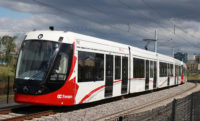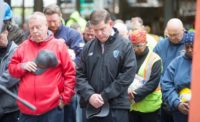When “The Embrace,” Boston’s monument to Martin Luther King Jr. and his wife Coretta Scott King finally makes its debut, it will mark the culmination of years of planning, design, permitting and construction work similar to what’s involved in bringing a sizable development project to life.
The 20-ft-tall bronze monument, which represents the Kings’ intertwined arms and hands, is slated to open next January on MLK Day.
The monument, in turn, will stand at the center of a tiled plaza, ringed in turn by a “Peace Walk” all designed to invite quiet contemplation and reflection.
However, while the public gaze is focused on Hank Willis Thomas’ planned monumental bronze sculpture, an array of contractors, design firms and a foundry on the other side of the country are busy working on a range of jobs needed to make the artist’s vision a reality.
In fact, a number of real estate and construction firms are involved in the project. Project management firm MGAC, which has a public art unit, is working with Thomas on everything from city permitting to contracting out the forging of the monument’s bronze pieces.
Local construction firm WES Construction is constructing footings, benches, pavers, lighting in the plaza that will surround the monument, while MASS Design did the design work.
Meanwhile, King Boston is working with Skanska, which is helping King Foundation, an off-shoot of the Boston Foundation, to manage its end of the construction process.
In a significant step forward, civic and political leaders and other dignitaries held a public groundbreaking for the project on April 27, Coretta Scott King’s 95th birthday. Hank Willis Thomas based the sculpture’s design on a photo of the couple embracing after Martin Luther King Jr. won the Nobel Peace Prize in 1964.
“I really saw this connection between the construction aspect and the art,” Sam Giarratani, public art manager for Songha & Company, the firm through which Hank Willis Thomas, the artist, conducts his business. “I really needed someone who could speak a language I couldn’t speak in terms of construction.”
Giarratani found that bridge to the construction world with MGAC, which has worked on 20 different public art installations since 2006.
MGAC, in turn, has helped guide the public art project through the Boston permitting system, with additional layers of review needed given the location on Boston Common, which has not had a new monument added in three decades.
That meant shepherding Thomas’ sculpture through the Boston Arts Commission and the plaza design through the Boston Parks and Recreation Dept., while also making sure Friends of the Public Garden were on board as well.
That took 17 months, with the project team not getting the final go-ahead until last fall.
“The process to get the public approvals took a lot longer than expected,” said Kris Collins, managing director for MGAC’s cultural practice group. “[The artists] are not always up for how complicated it can be to get all the approvals,” Collins, adding his firm acts a “bridge between how artists work and how developers and clients operate.”
MGAC also was in charge of finding a foundry that could handle the 66,000-lb bronze sculpture, which along with being 22 ft tall, is also 25 ft wide. The fingers alone range in length from 3 ft to 4 ft.
MGAC evaluated three or four potential candidates before eventually settling on Walla Walla Foundry in Washington State to fabricate and install the sculpture.
Meanwhile, while the foundry is at work casting the pieces of bronze that will make up the sculpture, Wes Construction and MASS Design are busy building out the plaza.
In this case, Wes Construction will be working directly for the city under a contract with the Boston Parks and Recreation Dept. The contractor will build out 90% of the plaza, leaving the final 10%, where the sculpture will be installed, untouched.
That part of the job will be handled by Walla Walla and will take roughly 12 days, and the help of two large cranes, MGAC’s Collins said.
The sculpture is so large that three tractor trailers will be needed to make the cross-country delivery from the foundry in Washington to Boston. Sections, in turn, are left open where the individual pieces connect to each other. The pieces are then attached through bolted connections, with small bronze panels welded over the openings and then finished and “patinated so that the pieces blend together,” Collins said in an email.
Neil Schwartz, project manager for WES Construction, said the laying out and construction of the plaza will be challenging, with need for absolute precision. If one piece or tile is off, it could throw everything off.
“There is no room for error anywhere on the line,” he said.





Post a comment to this article
Report Abusive Comment